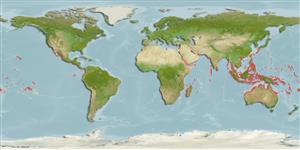>
Carangiformes (Jacks) >
Carangidae (Jacks and pompanos) > Trachinotinae
Etymology: Trachinotus: Greek, trachys, -eia, -ys = rough + Greek,noton = back (Ref. 45335).
More on author: Lacepède.
Environment: milieu / climate zone / depth range / distribution range
पारिस्थितिकी
समुद्री; खारा प्रवाल-भित्ति संयुक्त; गहराई सीमा 0 - 3 m (Ref. 89972). Tropical; 32°N - 32°S
Indo-Pacific: Red Sea to the Line and Mangaréva islands, north to southern Japan, south to Lord Howe and Rapa.
आकार / वज़न / Age
Maturity: Lm ? range ? - ? cm
Max length : 60.0 cm TL पुल्लिंग / अलिंग; (Ref. 4225); common length : 35.0 cm TL पुल्लिंग / अलिंग; (Ref. 5450); अधिकतम प्रकाशित वज़न: 1.5 kg (Ref. 30874)
पृष्ठीय रीढ़ (सम्पूर्ण) : 7; पृष्ठीय सौफट रेज़ (सम्पूर्ण) : 20 - 24; गुदा कांटा: 3; ऐनल सौफट रेज़: 20 - 24.
Adults occur near surface waters of lagoon and seaward reefs, in surge zones along sandy beaches (Ref. 48635, 90102). They always move in schools at the edge of the surf near the reef, usually in pairs or small groups in surface waters (Ref. 48635). They feed on small fishes (Ref. 9710). They are occasionally taken by trolling and line fishing.
Life cycle and mating behavior
Maturities | पुनरुत्पत्ति | Spawnings | Egg(s) | Fecundities | लार्वा
Paxton, J.R., D.F. Hoese, G.R. Allen and J.E. Hanley, 1989. Pisces. Petromyzontidae to Carangidae. Zoological Catalogue of Australia, Vol. 7. Australian Government Publishing Service, Canberra, 665 p. (Ref. 7300)
IUCN Red List Status (Ref. 130435)
Threat to humans
Harmless
Human uses
मात्स्यिकी: लघु वाणिज्य; आखेट मत्स्य: हां
साधन
Special reports
Download XML
इंटरनेट स्रोत
Estimates based on models
Preferred temperature (Ref.
123201): 24.7 - 29.3, mean 28.4 °C (based on 3280 cells).
Phylogenetic diversity index (Ref.
82804): PD
50 = 0.5000 [Uniqueness, from 0.5 = low to 2.0 = high].
Bayesian length-weight: a=0.01259 (0.00582 - 0.02724), b=2.96 (2.77 - 3.15), in cm total length, based on LWR estimates for this (Sub)family-body shape (Ref.
93245).
Trophic level (Ref.
69278): 3.6 ±0.52 se; based on food items.
लौटाव (Ref.
120179): माध्यम, न्यूनतम जनसंख्या दुगनी होने का समय 1.4 - 4.4 वर्ष। (Preliminary K or Fecundity.).
Fishing Vulnerability (Ref.
59153): Moderate vulnerability (44 of 100).
Nutrients (Ref.
124155): Calcium = 59.6 [27.7, 127.3] mg/100g; Iron = 0.837 [0.442, 1.569] mg/100g; Protein = 19.9 [17.9, 21.9] %; Omega3 = 0.113 [0.065, 0.209] g/100g; Selenium = 18.4 [9.9, 37.0] μg/100g; VitaminA = 80.1 [22.5, 267.8] μg/100g; Zinc = 1.2 [0.8, 1.7] mg/100g (wet weight);
